Text
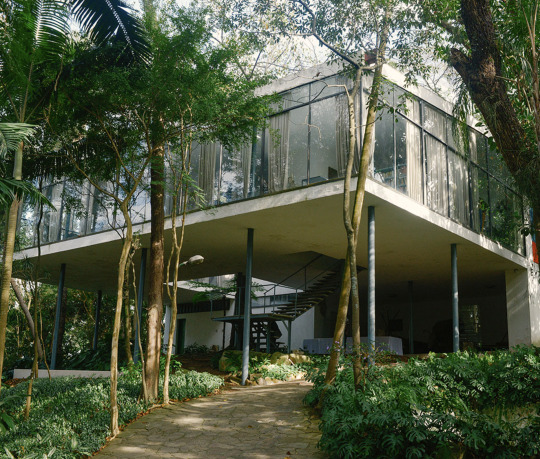
Casa de Vidro, Lina Bo Bardi, 1951
Happy International Women's Day :-)
10 FILMS ABOUT FEMALE ARCHITECTS
In any industry, work should be recognised for its merit, not the gender of the practitioner. Female architects shouldn't need their own list, or even that identifier. But although the gender balance is beginning to shift, we've had hundreds, maybe even thousands, of years of architecture in which the contributions of female designers haven't been equally recognised. Even in the past 44 years, the Pritzger has only twice not been awarded to a man, and Zaha Hadid remains the only solo female winner. 1991's award went to Robert Venturi for the work he and Denise Scott Brown did together, his request that she share it denied. A common theme in many of the films below is the delayed recognition of women whose influence and accomplishment should have been as famous in their time as male peers, but wasn't. Most have been discussed on this blog before - these artists deserve to be celebrated more than once a year.
1. GRAY MATTERS (2014) This documentary offers a comprehensive look at the legacy of Irish architect Eileen Gray, a pioneer of modernism whose significant contributions to design have historically been overshadowed by those of more famous contemporaries such as Le Corbusier.
2. PRECISE POETRY: THE ARCHITECTURE OF LINA BO BARDI (2013) A documentary about this influential Brazilian architect. The Italian-born designer helped shape a distinctly Brazilian style of tropical modernism, focused on the social and cultural potential of buildings.
3. CITY DREAMERS (2018) This documentary visits four trailblazing female architects: Phyllis Lambert; Blanche Lemco van Ginkel; Cornelia Oberlander and Denise Scott Brown. For most of their long professional careers, these women worked in an almost exclusively male domain. Structured around their personal anecdotes and recollections, the film looks at their important contributions to city making.
4. LILLY REICH, THE FORGOTTEN MODERNIST (2021) Two well researched videos discussing the long-overlooked Lilly Reich, a long time Mies Van Der Rohe collaborator, who was partly, if not mostly, responsible for the iconic Barcelona Chair.
5. ZAHA (2023) This documentary provides a nice introduction to Zaha Hadid's work, especially because it begins with the origins of her unique artistic language - her student days and early unbuilt works.
6. THE ARCHITECTS SERIES: GRAFTON ARCHITECTS (2023) In a discipline which has always celebrated big egos and individualistic style, the choice of Grafton's Yvonne Farrell & Shelley McNamara as 2020 Pritzker laureates felt refreshing and long overdue. This short documentary emphasises the inclusiveness and gentleness of their approach to design, and to practice - a desire for a collaborative office without any one designer's name on the door.
7. CHARLOTTE PERRIAND: A BRIEF OVERVIEW (2013) Perriand achieved wider recognition in her lifetime than most of her female contemporaries. But it's only in recent years that certain designs, such as the iconic Chaise Lounge previously credited to Le Corbusier, have emerged as being substantially, if not totally, her work. In the absence of good documentaries on Perriand, this video provides an interesting introduction.
8. REACHING FOR THE MOON (2014) This nicely-shot biopic of Brazilian architect Lota de Macedo Soares is unremarkable as a movie, but it does provide us with a beautiful virtual escape to her buildings, and their garden setting. It’s also based on an interesting true story - that of her relationship with Pulitzer-winning poet Elizabeth Bishop.
9. 100 WOMEN ARCHITECTS IN THE STUDIO OF FRANK LLOYD WRIGHT (2009) Short documentary examining the legacy of the female architects trained and employed by FLW, who were notably numerous in comparison to almost any other school or practice of the time.
10. TIEBELE WOMEN PAINTING THEIR HOUSES (2008) An interesting and calming little amateur video which depicts, without spoken commentary, the process of decorating the exterior of rural adobe homes with local materials and traditional motifs. There may be no architecture degrees on the walls, and the lines between designer, artist and craftsperson are blurred, but the resulting buildings are as beautifully distinctive as any in the world. Photograph: Sekushy, via Yellow trace
#international women's day#architecture#female architects#lina bo bardi#modernism#brazilian architecture#charlotte perriand#eileen gray#zaha hadid#grafton architects#tropical modernism
151 notes
·
View notes
Text

Heritance Kandalama, Geoffrey Bawa, 1995
As I mentioned in a recent post on South Asian Architecture, Geoffrey Bawa's work has finally received the cinematic showcase it deserves, with two films dedicated to his buildings released in the past two years. The Sri Lankan architect was a formative figure in tropical modernism, blending buildings with nature, and vernacular traditions and materials with western modernism.
Neither BAWA’S GARDEN (2022), nor GENIUS OF THE PLACE (2023) are available to stream online yet, but this video also provides an interesting introduction to Bawa's life and work. Photo: Frederic Lagrange/Trunk via nytimes
210 notes
·
View notes
Text
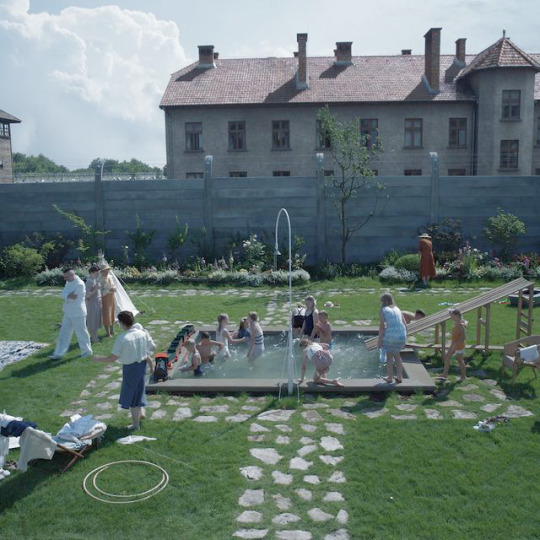
The villa of Commandant Höss: a "paradise" which shared a wall with Auschwitz.
ARCHITECTURE OF GENOCIDE: THE ZONE OF INTEREST (2023)
Before I saw this film, I'd assumed that it would illustrate the way architecture can be used to facilitate denial or self-deception. Like PARASITE (2019), in which one - in that case wholly fictional - family creates a lavish domestic retreat from which they can't see the overcrowding, poverty and suffering that surrounds them. But although Hedwig Höss speaks of planting vines to cover the wall they share with Auschwitz, there's no pretending this neighbour isn't there. The Höss's live in a pristine 1937 villa, with a manicured garden where they have parties and their children swim in a pool, and this juxtaposition is chilling. But they can still see the chimneys, and hear the screams, and nobody is denying what's next door.
This is one of the most horrifying movies I've seen, and that's due to the banality of the domestic scenes. We aren't watching a stereotypically deranged mass murderer, or even a psychopathic commandant at work inside the camp. Instead we see a comfortable house, a beautiful garden, two parents who love one another and their children. And who've somehow been able to assimilate the fact that millions are being murdered behind their garden wall.
The film is based loosely on a novel, but also on research into the lives of the real Höss's. A replica was built of their villa and garden, only metres from where the real home still stands. It's suggested that the real Rudolf and Hedwig considered themselves homesteaders, reclaiming rural territory for the 'master race', as was the Nazi ideal. In the film, Hedwig repeatedly emphasises the role of building and grounds as a status symbol. Their villa had been taken from its Polish owners and architecturally altered to fit the Höss's image. Most of the items inside would have been plundered from Jewish homes, and others, such as stools, and the wheelbarrow full of smaller seized items, would have been custom-made by prisoners. This isnt a home that is genteel in spite of the camp next door. On the contrary, everything about it, down to the fur coat on Hedwig's back, exists as a result of persecution and genocide.
The Zone was an exclusion area of over 40 sq. km around the camp, created after Poles and Jews were expelled from nearby villages. It's jarring how idyllic it appears in the film, with meadows, birdsong, a gently babbling river. While obviously not as horrifying as human apathy, the indifference of a place to the evil it houses is disconcerting, especially if you're in a profession like architecture or urban design, where places are thought to be somehow expressive of what occurs within them. We do see the horror occasionally seep beyond camp walls - a practiced scramble to leave sun loungers as crematoria smoke seeps into the garden, a wash of ash infiltrating the picturesque river.
It's likely that the filmmakers were using the extreme example of this family to remind us of our own ability to become apathetic and desensitised to the suffering of strangers, particularly when we feel our personal safety and comfort may be threatened. (Current campaigns to essentially criminalise poverty in the form of homelessness in certain cities, come to mind). Obviously the murder of millions is an evil on a completely different scale, and I have to believe that 99% of us wouldnt be capable of the Höss's actions, but it's a chilling and worthwhile reminder nonetheless.
62 notes
·
View notes
Text
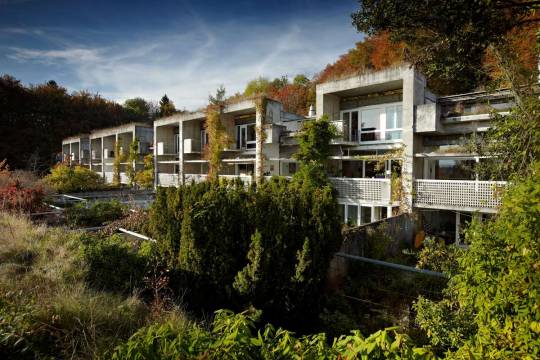

Siedlung Halen, Atelier 5, 1961
“More than 50 years on, it’s one of the most successful housing estates in existence“
PARKOUR HALENSIEDLUNG (2007), SIEDLUNG HALEN (2010)
These videos offer two perspectives on the iconic Halen development - one looks at history and design detail, while in the other its massing, human scale, and playfulness are demonstrated through parkour.
The 79-home Swiss project was designed by 5 young architects on a forested site overlooking a river, 15 minutes cycle ride from Bern. The land had been intended for their own houses, until costs necessitated a higher density. Communal facilities such as the swimming pool, playground and community hall have shared ownership, and the internal streets are pedestrianised. For additional reading, this feature in Monocle (quoted above) includes short profiles of some of the residents. They reflect the fact that the buildings, arranged on a slope with high walls between gardens, seem to have found a sweet spot between community and privacy. As one resident says: “You can sunbathe on the top floor balcony as God intended without anyone seeing.”
Perhaps part of Halen's success lies in how well it resolves two areas of tension in our relationship to spaces. Firstly the public/private balance, something like what Le Corbusier referred to as "silence, solitude, but also daily contact with mortals.” And secondly, Prospect Refuge theory, in which we crave immersion within nature, but also shelter from it - a view of the surrounding landscape, but also a feeling of enclosure and protection.
430 notes
·
View notes
Text

The Glass House, Philip Johnson, 1949
INSIDE THE ICONIC GLASS HOUSE (2023)
If you haven't had an opportunity to explore this building in person, there are several films which allow us to visit it remotely. This video from Open Space introduces us to the house and grounds, and gives some context and background on Philip Johnson, who, prior to designing it, had made a career change in his 30's to begin studying architecture. Another film which nicely illustrates the property is GLASS HOUSE (2019), in which photographer David McCabe revisits it, and talks about the images he took there of Andy Warhol. (Photo by Eirik Johnson)
#glass house#philip johnson#modernism#minimalist#mid century modern#international style#steel frame#architecture#painting
95 notes
·
View notes
Text
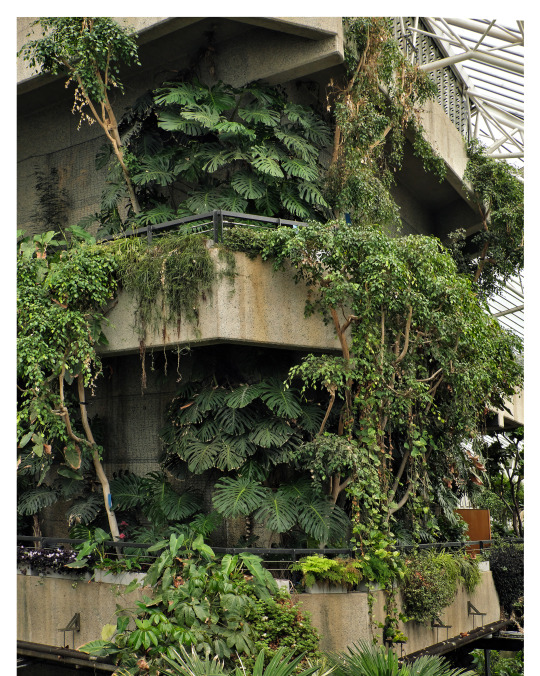
Barbican Estate, Chamberlin, Powell and Bon, London, 1965-1976
....and we're back! I'd like to apologise for the long absence, and to thank everyone so much for their patience, and for sticking around! Architecture+Film will be resuming regular fortnightly posting from now x
THE KITCHEN (2023)
London's Barbican can be visited cinematically in dozens of movies, documentaries and music videos, many of which have been discussed here in previous posts. Its most recent appearance is in dystopian thriller The Kitchen, starring rapper Kano. The movie makes use of a near-future sci fi scenario to comment on present-day housing inequality. It was filmed in both London and Paris, and the Barbican Conservatory provides the interiors for the central character's workplace, an ecological funeral home. (Photo: me, via instagram)
#barbican#the kitchen#kano#brutalism#movie architecture#ian wright#london architecture#barbican conservatory#tropical modern#green architecture
355 notes
·
View notes
Text

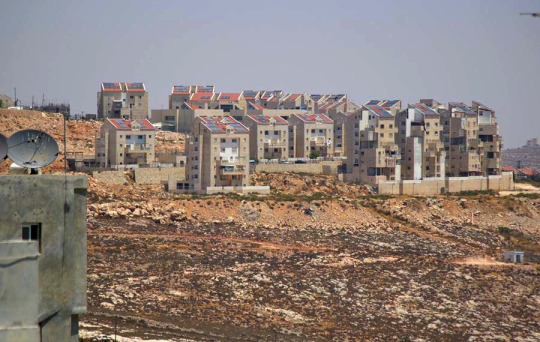
"Settlement" housing surveys and dominates the landscape, West Bank, Palestine
THE ARCHITECTURE OF VIOLENCE (2014)
It feels like an important time to revisit this short documentary. Part of the Rebel Architecture series, the film examines, clearly and concisely, the use of design as a weapon of intimidation and subjugation within the Palestine Israel conflict. One element it focuses on is Palestine's 'architecture of occupation': the way the built environment, even in the form of suburban 'settlement' housing (in which tracts of Israeli homes have been built in occupied territories like the West Bank), has been deliberately shaped to intimidate, surveil, segregate, and even dehumanise.
"Settlements are built on hilltops, overlooking Palestinian valleys, to dominate. They're laid out to create a suburban-scale optical device that can survey the territory. The bright red roofs of the houses are mandated by law... to allow military to understand what's friend and foe: where to bomb and where not to."
"...When you put Israeli colonies on highways, you accelerate Israeli movement through the space. In the same way, with every twist and turn of terrain, Palestinians encounter a checkpoint, a border, a fence, a valley they cannot cross..."
It's important for architects and urban designers everywhere to understand that our craft has the potential to be weaponised. It's important that, no matter whom the client, we think about how a project will impact everyone whose life it touches. But sadly, as essential as these considerations are, they're of no immediate help to civilians from both sides who are suffering in Gaza and the rest of Palestine and Israel right now. So, it seems worth sharing:
Some ways that we can help:
1. Speak up. Send an email to your elected representative. Sign petitions. Stand up in any forum you can against human rights violations, and against both islamaphobic and antisemitic behaviour.
2. Contribute to a trusted aid organisation working in Gaza, such as Unicef or the British Red Cross. Sites like charitynavigator and charitychecker can be used to check it's a group who'll use it well.
3. Understand the context. Short videos here and here provide a clear introduction/overview.
4. Boycott companies that are directly profiting from the illegal occupation, and from human rights violations.
(Images: Ronen Zvulun/Reuters via Guardian, Léopold Lambert/Funambulist)
626 notes
·
View notes
Text

AmericasMart, Atlanta, John Portman Architects (Building 3, 1979)
More than 80 movies, television shows and music videos have been filmed in John Portman's neofuturist buildings. The most frequently used are the Peachtree Centre, which appeared in ANT MAN AND THE WASP (2018), BABY DRIVER (2017), and dozens of other productions, and Westin Bonaventure, where INTERSTELLAR (2014) and MISSION IMPOSSIBLE III (2006) were shot. The AmericasMart complex can be seen in DIVERGENT: INSURGENT (2014), FUTURAMA (EP.16) (2000). Photo by Isaiah King on Flickr
135 notes
·
View notes
Text

Amber Fort, Rajasthan, 16th century
FILMS FEATURING NON-WESTERN ARCHITECTURE PART 2: SOUTH ASIA
I shared PART 1: AFRICA, because I'd realised how much my design education benefitted from a childhood home that was full of National Geographics rather than Architectural Digests. Architecture school curriculums can be very western-centric, and often exclude building traditions in which whole communities, rather than a single architect, contribute. When you add this to the relative difficulty of visiting some regions in person, it’s possible to miss works of amazing beauty and innovation.
1. Rajasthan's 8th Century Chand Baori Step Well was built to conserve as much monsoon water as possible. The distinctive structure was used in THE DARK KNIGHT RISES (2012), THE FALL (2006), BHOOL BHULAIYAA (2007) and BEST EXOTIC MARIGOLD HOTEL (2011).
2. HUMAN PLANET, EP.7 RIVERS (2011) Part of this episode explores the amazing Living Root Bridges of the Meghalaya region of India, which were formed by weaving live rubber tree roots in a symbiosis of natural and human engineering.
3. OCTOPUSSY (1983) In this bizarre Bond Film, Roger Moore infiltrates the titular character's floating home, filmed at what was originally the 18th century Udaipur Palace, Jag Niwas. The site was converted in the 1960s into the Taj Lake Palace Hotel.
4. REBEL ARCHITECTURE: PAKISTAN, A TRADITIONAL FUTURE (2016) This episode looks at the work of Pakistani architect Yasmeen Lari, who helps to rebuild and future-proof villages in the flood-stricken Sindh region, using local materials and indigenous techniques.
5. BHUTAN ARCHITECTURE TOUR (2020) A nicely shot video which follows a group of Indian students on an architectural tour. It doesn't go into depth, but provides an interesting visual introduction to some traditional Bhutanese architecture. The last building visited is the iconic 7th century Paro Taktsang (Tiger’s Nest Monastery). There's some misinformation online about this being a location in Christopher Nolan's BATMAN BEGINS (2005), but that was a cgi building, and the scenes were shot in Iceland.
6. Sri Lankan architect Geoffrey Bawa blended buildings with nature, and vernacular traditions and materials with modernism. His work has long deserved to be showcased cinematically, and finally two films dedicated to his architecture have come out in the last couple of years, BAWA'S GARDEN (2022), and GENIUS OF THE PLACE (2023). Neither are currently available to stream online, but this video provides an interesting introduction to Bawa's life and work.
7. THE MINARET OF JAM (2018) A short video from UNESCO, which looks at the the spectacularly-sited 12th Century Minaret and Archaeological Remains of Jam, in Afghanistan. The 65 metre minaret is on UNESCO’s List of World Heritage in Danger, and this looks at the process of documenting the structure for preservation.
8. STUDIO MUMBAI (2012) A short film by Daniele Marucci looking at the design and artisan construction processes employed by this small but renowned Indian practice, which fuses vernacular architecture with modernism.
9. The 16th Century Amber Fort and Palace in Rajasthan has been used as a filming location for many Bollywood movies and TV shows, including JODHA AKBAR (2013-15), KHOOBSURAT (2014), and BAJIRAO MASTANI (2015). Of the countless YouTube travel vlog offerings about this fort and palace, this short video seems to offer the most succinct and informative video tour.
10. STUDIO SANGATH (2023) B V Doshi’s humanist approach to design, and blending of Western and Indian influences has inspired generations of architects. In this nicely-made short video, his granddaughter Khushnu Panthaki Hoof, also an architect, gives us a tour of his studio.
11. SHAH JAHAN MOSQUE THATTA (2019) A short, nicely-shot video, which takes us on a tour of this building, and includes aerial footage of its layout and context. Photo: Amber Fort, by Photo by Annie Spratt on Unsplash
#south asian architecture#world architecture#indian architecture#geoffery bawa#amber fort#non western architecture#Rajasthan#pakistani architecture#bhutan#architecture#ganesh pol
34 notes
·
View notes
Text

Barcelona Pavilion, Mies Van Der Rohe and Lilly Reich, 1929.
MIES ON SCENE (2018)
As an architect or design-lover, we can forget that others may see the built environment differently. This film opens with some responses to the Barcelona Pavilion from passers by: "I hadn't noticed it at all" ..."not pretty or ugly, just regular" ... "it jars a little, too modern"... "No (I don't like it), it's quite plain". The documentary (which can be watched free with a library card via the link above) looks in detail at the building's origins and architectural legacy. More than any other I've seen on the subject, it's a rewarding opportunity to explore the space virtually. However, this is somewhere best visited in person - something which the generations of architects who were inspired by it were unable to do, as it didn't physically exist between its temporary 1929 exhibition, and 1986 reconstruction. Perhaps if they had, we might have been spared some of modernism's less generous products. It's hard to imagine a purer expression of Van Der Rohe's belief that "God is in the details", a reminder that these formative modernist structures were truly about less being more: ornament removed, but an equal complexity and richness replacing it through materiality and beautifully expressive construction details.
The film also touches on something which I'll explore in a future post, which is the significant influence on Mies's work of textile designer Lilly Reich, who was the artistic director for this German contribution to Barcelona's World Exposition. (Photo: me, via instagram)
#barcelona pavilion#mies van der rohe#modernism#architecture#minimalism#international style#documentary
75 notes
·
View notes
Text
"Not for ourselves alone are we born"
Marcus Tallius Cicero
THE HOLDOVERS (2023)
The buildings in this movie are, to each of the main characters, simultaneously a prison and a cherished home. Like many venerated and historic schools, the fictitious Barton Academy (filmed at several different Massachusetts colleges) is an architectural mixture of imposing grandeur, and bland and utilitarian institutionalism. Its snowy isolation emphasises the school's status as a self-sufficient island, not connected in any meaningful way to the local 'townies' and their community. It's not a movie about architecture, in any signaificant way, I'm just mentioning it here because it's a lovely film, and a great alternative Christmas movie to add to the list for next year.
16 notes
·
View notes
Text

Urban Farming Office, VTN Architects, 2022
Unfortunately, vegetation-covered buildings can seem gimmicky sometimes, if climate, species, and the long term viability of the 'living' structure haven't been well considered. I've heard planting in architecture or masterplanning referred to cynically by designers as 'green sauce' - which often doesn't survive beyond the renderings, due to financial constraints or the complications of responsibility for ongoing maintenance.
But Vietnam has a climate well suited to supporting lush greenery, along with hot, dense concrete cities which are in need of greening to make them more liveable. VTN architects have focused their work on finding ways to create more sustainable buildings and cities in hot environments, using passive techniques, particularly urban planting. This building houses their studio, and seems mainly intended to illustrate that vertical urban farming is possible, whilst utilising the cooling and ecological benefits of the green facade. The focus doesnt seem to have been on creating a viable working farm in this instance - whilst apparently some plants used are edible, clearly many are not. The building can be seen in this video, and Vo Trong Nghia discussed the firm's approach in GREENING THE CITY (2014) and talks in detail about many of the firm's projects - some of which involve beautiful and innovative structural use of bamboo - in LIVING CITIES KEYNOTE (2022). (Photo: Hiroyuki Oki via dezeen (edited))
#living building#green architecture#sustainable architecture#urban farming#vtn architects#vo trong nghia#vietnam#saigon
132 notes
·
View notes
Text

ROMANCE MOVIES FOR ARCHITECTURE / URBAN DESIGN ENTHUSIASTS
Happy Valentine's Day, everyone! As always, here's the annual list, with some new additions.
1. IN THE MOOD FOR LOVE (2000) Widely considered to be one of the most beautiful films ever made, this is as much a lyrical portrait of 1960′s Hong Kong as it is a tale of doomed romance. The 12th Century Temples of Angkor Wat also make an appearance.
2. PAST LIVES (2023) A bittersweet musing on romantic destiny and cultural identity, this film is also a fond ode to New York. Brooklyn's Jane’s Carousel, in its Jean Nouvel-designed pavilion, features in a key scene. Its used as a reference to nostalgia, and as a nod to the questions of fate and destiny with which the characters are grappling.
3. EMMA (2020) This was shot on location at the 16th Century estate of Firle Place, whose interiors were refitted to evoke a bright, candy-coloured dollhouse, symbolising Emma’s well-intentioned manipulation of others’ lives. The distinctive macaron-style colour scheme looks contemporary, but is historically accurate: the now-faded decorative items of the Regency era were once very vibrant, with bright colours favoured as a way of indicating prosperity.
4. BERGMAN ISLAND (2021) This gently-paced film provides a cinematic escape to the beautiful Swedish island of
Fårö, a small community where director Ingmar Bergman lived and shot several of his films. Multiple dwellings from the Bergman Estate feature in the film, especially the dark stained mid century 'Hammars', a unpretentious and quietly beautiful house set on a rocky shore, where Bergman lived from 1967 until the end of his life.
5. COLUMBUS (2017) This was marketed as a romance film, but whether or not it is one depends on your interpretation of the central relationship. Either way, there’s no doubt that it’s a great movie for people who love mid century architecture.
6. ONLY LOVERS LEFT ALIVE (2014) In the sub-category of Night-time Cities in Films, this has no equal. I’m yet to visit Detroit, but no other movie has captured, for me, the exact feel of after-dark Tangier. In both locations, Jim Jarmusch has harnessed an exotic, seedy, beauty that perfectly matches his characters and story.
7. CALL ME BY YOUR NAME (2017) Luca Guadagnino is known as a ‘director of the senses’ - unusually adept at evoking for us the sights, sounds, and even the smells and tactile experiences of a time and place (such as a 16th Century villa in 1980′s Italy). But here he accomplishes something beyond this - enabling us to momentarily feel for ourselves the sensation of falling deeply, precariously, in love.
8. A SINGLE MAN (2009) This story of love and loss stars John Lautner’s 1949 Schaffer Residence. The film’s immaculate Mid-Century style is the result of a collaboration between director Tom Ford and Mad Men production designer Dan Bishop.
9. BEFORE SUNSET (2004) As in the previous instalment of this trilogy, the pleasures of wandering around an unfamiliar city provide this film with its context and structure, and also reinforce its romantic theme of a journey of accidental discovery.
10. I AM LOVE (2009) A Jill Sander-clad Tilda Swinton is the conflicted matriach of a wealthy Milanese family, living in Piero Portaluppi’s 1935 Villa Necchi.
11. MAESTRO (2023) This biopic was filmed in New York City, Connecticut, and at Tanglewood, a music venue founded in 1938. Much of the film takes place in the Bernsteins' apartment in New York's Dakota building. The home was recreated as sets, but for the scenes which took place at the family's Connecticut weekend house, that actual property was used.
12. HER (2008) Spike Jonze’s near-future LA is a cleaned up, greened-up amalgam of the actual present-day city and the Pudong business district of Shanghai, infused with the palette of a Jamba Juice store.
13. PORTRAIT OF A LADY ON FIRE (2019) This film encourages us to gaze, unashamedly, at every detail of its sparsely beautiful 18th Century interiors, spectacular coastal landscape, and cast of four female characters. And it generously imbues that gaze with significance, by aligning it with that of an artist, or a lover.
14. LOST IN TRANSLATION (2003) The loneliness, cultural disorientation, and general sense of freedom and discovery that come with being in an utterly foreign city provide the catalyst for an unexpected romance.
15. MANHATTAN (1979) See this film for a visit to Frank Lloyd Wright’s Guggenheim Museum, and for the fact that its central love story actually takes place not between the characters of Isaac and Tracy, but between Woody Allen and New York.
16. BLADERUNNER (1982) As with some of the others, this isn’t technically a romance film, but its love story is as integral to the movie as Frank Lloyd Wright’s Ennis House, Sumner Hunt/ George Wyman’s Bradbury Building, and that perpetually rainy cyber-punk city. Cinema’s most beautiful (and romantic) urban dystopia.
17. BRIEF ENCOUNTER (1945) One for all the urban designers out there, this is a film about two individuals who are drawn into each other’s lives by the use of public transport :-). For a less iconic riff on the same theme, there’s also the Meryl Streep / Robert De Niro FALLING IN LOVE (1984) (in which De Niro plays an architect). Both films celebrate the kind of chance encounters which are missed when sitting alone in a private vehicle.
HONOURABLE MENTIONS: CHUNGKING EXPRESS (1994), WALL E (2008), WINGS OF DESIRE (1987), THE PHANTOM THREAD (2018), THE ROYAL TENENBAUMS (2001), ONCE (2006), LA JETEE (1962), AMELIE (2001), THE FAULT IN OUR STARS (2014), À BOUT DE SOUFFLE (1960). (Photo: Schaffer Residence, John Lautner, 1949 (A Single Man) jasonschmidtstudio for AD France)
#architecture#romance#movies#urban design#list#valentines day#john lautner#schaffer residence#mid century modern#bladerunner#in the mood for love#before sunset#only lovers left alive
75 notes
·
View notes
Text

Wall Drawing number #373, Sol LeWitt, 1983
SOL LEWITT: WALL DRAWINGS (2010)
This is an interesting and inspiring documentary, which you should be able to view for free in most regions (via the link above), if you have a library card.
LeWitt's Wall Drawings are very architectural, due partly to their scale, and the fact that they were conceived in relation to a space, but particularly because of their method. As a conceptual artist, LeWitt didn't usually execute the final drawing himself. He visualised them, then specified detailed instructions to an installation team, which may have included dozens of artists, such as (for drawing 797): "The first drafter has a black marker and makes an irregular horizontal line near the top of the wall. Then the second drafter tries to copy it (without touching it) using a red marker. The third drafter does the same.." ) The 'artwork' was the concept itself, the idea and instruction, while the completed drawing was merely the proof/manifestation of it - 'the traces of a performance'.
As in architecture, there is the challenge of knowing that the final nature of your exhibited work, as it is experienced by the world, is not entirely within your control - in Le Witt's case, this was something he wanted, and the collaborative, evolving nature of the image was an important element of the piece. (Photo: Wall drawing, Gemeentemuseum staircase. via theeyespies )
#sol lewitt#wall drawings#art#conceptual#colourful#documentary#mural#architecture#architectural drawing#Gemeentemuseum#staircase
174 notes
·
View notes
Text

Sheats-Goldstein Residence, John Lautner, 1963.
TEN FILMS ABOUT ARCHITECTURE
Just before Architecture+Film took a break, we were asked by Shelter to choose ten titles for them to feature that month. Although that was a while ago, now that we're back it still seemed worth sharing the list for anyone who's interested.
1. COAST MODERN (2012) A documentary which focuses on the organic, nature-integrated style which emerged in American west coast modernism, in the early to mid twentieth century. Contains more homes that I'd love to live in than any other film I've seen.
2. INFINITE SPACE: THE ARCHITECTURE OF JOHN LAUTNER (2009) A feature-length documentary which explores Lautner’s iconic modernist structures.
3. LA CUPOLA (2016) This isnt a documentary, but rather an atmospheric visual exploration of a beautiful, enigmatic, and weather-ravaged structure: A concrete dome in Sardinia, commissioned by Michelangelo Antonioni and Monica Vitti (Director and star of L'avventura, respectively), who then separated before its completion. I'll share a longer, dedicated post on this short film soon.
4. THE PRUIT IGOE MYTH (2011) A thought-provoking documentary about the infamous St Louis Housing project. The residential tower blocks deteriorated rapidly from utopian plan to militant slum, as a result of systemic racism, suburban migration, and other social and political factors overlooked by their creators. The demolition, only 20 years after completion, was seen by many to represent the death of modern architecture.
This film is a worthwhile watch as a cultural and historical document, but also as a reminder of the long-term complexity of creating successful places, and the naivety (or arrogance) of believing they can be achieved by an architectural vision alone.
5. GRAY MATTERS (2014) This documentary offers a comprehensive look at the creative legacy of female Irish architect Eileen Gray, a pioneer of modernism whose significant contributions to design have historically been overshadowed by those of more famous contemporaries such as Le Corbusier.
6. THE EXPERIMENTAL CITY (2017) An interesting and thought-provoking documentary about a large federally-funded project during the 1960′s and 70′s, to create a new city in which different sustainable technologies and ways of living could be tested. I've reviewed it in more depth here.
7. CITY DREAMERS (2018). This documentary visits four trailblazing female architects, Phyllis Lambert, Blanche Lemco van Ginkel, Cornelia Oberlander and Denise Scott Brown. For most of their long professional careers, these women worked in an almost exclusively male domain. Structured around their personal anecdotes and recollections, the film looks at their important contributions to city making.
8. DO MORE WITH LESS (2017) A group of young Latin American architects look to change the way the profession interacts with society, learning through real-world projects, and looking for low-budget solutions in collaboration with local users, and local materials.
9. UNFINISHED SPACES (CUBAN ARCHITECTURE OF THE REVOLUTION) (2011) In 1961, a newly victorious Fidel Castro went golfing with Che Guevara, and decided to repurpose the picturesque course to build a cluster of national art schools. This documentary presents the construction process which followed as a metaphor for the revolution itself. By the mid 60′s the organic and individualistic styles of the elected architects had lost favour, as mass produced Soviet-style construction methods became seen as more politically appropriate. The vast project stalled - incomplete, decaying, but partially occupied. 40 years later the architects were invited back to resurrect their vision.
10. PERMANENT CAMPING A short exploration of a building that's featured on this blog before, Casey Brown's elegantly simple shed, Mudgee, which sits on a remote and rugged site in rural Australia.
Note: This post isn't sponsored, and just so you know, Shelter is a paid film streaming service. I often share links to free services for architecture documentaries, but none have this particular list of films available.
(Photograph by Tom Ferguson. Sheats Goldstein Residence appears in Infinite Space: The Architecture of John Lautner)
#architecture#documentary#sheats goldstein residence#john lautner#modernism#mid century modern#brutalism#coast modern#la cupola#pruit igoe#film list
156 notes
·
View notes
Text
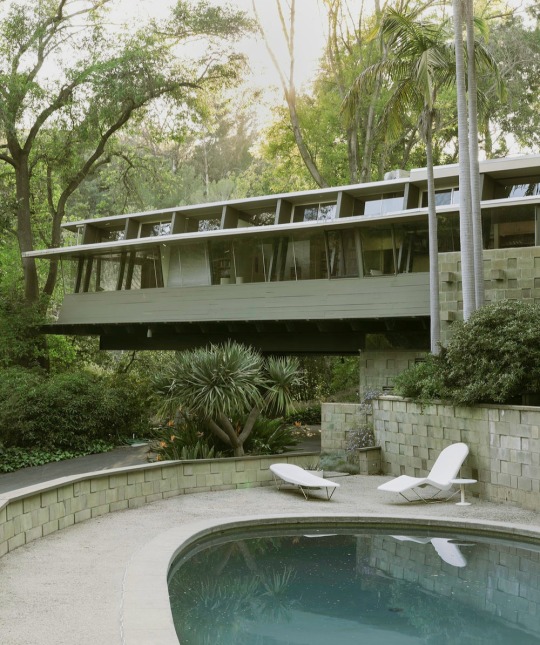
MHA House, 1947, A Quincy Jones, Jim Charlton
MHA: SITE OFFICE (2019)
Four friends, returning from WWII, pooled their money and bought an acre of land. They hired a pre-Eichler A Quincy Jones, along with Whitney R. Smith, and engineer Edgardo Contin, and built four homes. The group formed the non profit Mutual Housing Association, and through this many more homes were then built in the area, several by renowned mid century architects.
This video takes us on a short tour of MHA's site office and studio, which was converted to a residence in 1956, and more recently restored by architect-owner Cory Buckner. The site was planned so that the houses sat on its corners, at angles to the street and each other, with a central communal pool and play area, which diminishes the sense of internal boundaries, and allows uninterrupted views of the greenery.
#mid century modern#architecture#quincy jones#los angeles#tropical modern#mha house#landscape architecture#cory buckner
199 notes
·
View notes
Text

House Bordeaux-Le Pecq, Claude Parent, 1965
CLAUDE PARENT, VISIONARY ARCHITECT (2020)
A short video created in conjunction with an exhibition of Parent's highly experimental work. The film provides an introduction to the influential designer, who trained Jean Nouvel, and inspired architects such as Zaha Hadid, Rem Koolhaas, and Daniel Libeskind. "He was a vibrant thinker. He wasn't worried about what was going on around him in normal practices, he was unabashedly himself. And his drawings were extraordinary - beautiful fantasies, full of poetry" - Frank Gehry. Photo: architecturedecollection
353 notes
·
View notes